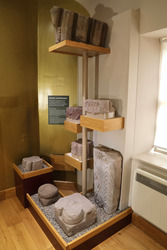
The Corpus of ROMANESQUE SCULPTURE in Britain & Ireland

Museum
Carved fragment discovered in 1984 by Mr Jack Flynn and Mr Martin Timoney in a ruined farmhouse at Carrowculleen, where it was built into the north gable wall of the house. It was acquired by the National Museum of Ireland in 1990 (Reg No. 1990.129, File no. IA/295/88).
Museum
The museum contains five fragments of Romanesque sculpture. There are also sections of plain roll moulding, two in the garden and a double roll in the museum, all probably of 12thc. date.
Museum
A number of Romanesque carved stones from a range of sites in Fermanagh are held in the museum collection. These comprise a fragment carved with an ecclesiastical figure from St Ronan's church, Aghalurcher; two delicately carved fragments from Inishkeen Island; a fragment of a carved head from Kiltierney; part of a cross head from Killesher and section of window-head found at Slattinagh Frevagh Church Site (Kilcoo).
Museum
Until the mid-20thc., the stoup was found placed against the N wall of the only surviving section of a chapel built in the 13thc. for the Sinclair family. There is no record known of how and when the stoup made its way into this building. In the mid-1950s, the stoup was given to the National Museum of Scotland, where it remains.
Museum
The church at Kirknewton was united with that of East Calder in 1750 and a new church built elsewhere. In about 1780, the majority of the old church appears to have been taken down. The following year, a voussoir with chevron and erotic figures was given to the Society of Antiquaries of Scotland.
Museum
The 16 pieces of the coped gravestone were found in a ditch next to the graveyard at Nisbet. Since then they have been put back together and the grave cover is now in the museum at Wilton Lodge in Hawick.
Museum
Museum on the Orkney Isles has fragments from St Ola's church, Kirkwall (destroyed, no traces remaining on its former site), St Magnus Cathedral, and more.
Museum
The block of stone, carved with circle and interlace on both main faces, is now part of the National Museum of Scotland Collection. According to the 1892 Museum inventory description, it came from the churchyard at Mid Calder and was given to the museum in 1883. Its inventory number is IB 129.
Museum
Two carved heads from different sites are now housed in Limerick City Museum.
One carved head was found incorporated into the stonework of the old Protestant church at Feakle (Clare), built in 1824. It was found during the demolition of the church in c.1954.
The second carved head was found on the site of St Peter's Cell, Limerick.
Museum
St Vigeans Museum was opened in 1960. Formerly the carved stones were kept inside the parish church, but they were moved to the museum when it was established. Many of the stones date from the Pictish period, but a few are 12thc. All of these appear to have been found built into the later church walls.









